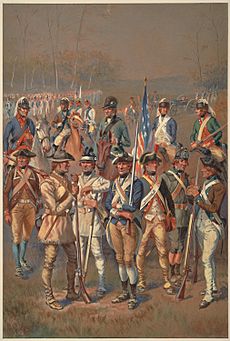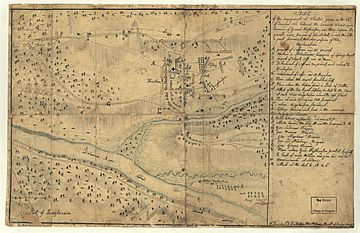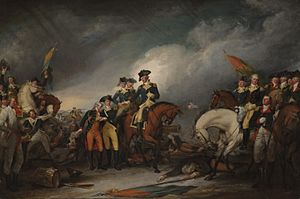Order of battle of the Battle of Trenton facts for kids
The Battle of Trenton was a major fight during the American Revolutionary War on December 26, 1776. George Washington led the Continental Army in a surprise attack on German soldiers, known as Hessians, who were staying in Trenton, New Jersey. The Hessians were led by Colonel Johann Rall, who was badly wounded and later died. About two-thirds of his soldiers were captured. This victory was very important because the Americans had lost many battles before this. It greatly improved their spirits and was followed by two more American wins: a second battle in Trenton on January 2, 1777, and then the Battle of Princeton on January 3.
Most of the German soldiers were from three Hessian regiments: Rall's, von Lossberg's, and von Knyphausen's. They also had some artillery and a small group of British soldiers. The American army included regular Continental Army units, their artillery, and some local militia. Other American groups were supposed to join the attack or create distractions, but they couldn't cross the icy Delaware River and missed the battle.
Hessian and British Forces
When the war started in 1775, the British government realized it needed more soldiers than it could find in Britain. So, they hired troops from other countries in Europe, mostly from German areas. The largest group, over 12,000 soldiers, came from a place called Hesse-Kassel.
The Hessian soldiers stationed in Trenton were a group of about 1,400 men, nearly all from Hesse-Kassel. Their commander was Colonel Johann Rall. This group included three main regiments, each with its own artillery. There was also a small company of Hessian Jäger (who were like light infantry) and a few British 16th (Queen's) Light Dragoons soldiers.
The Hessian regiments were named after their main officers. However, these officers were often busy with other duties and not always with their regiments. For example, Colonel Rall commanded the entire group, so his own regiment was led by a different officer.
Here's a quick look at the Hessian and British units involved:
| Hessian and British Units | ||||
|---|---|---|---|---|
| Unit | Commander | Soldiers | Losses | Notes |
| Rall's Brigade | Col. Johann Rall | 1,354 | 17 killed 78 wounded 868 captured |
This was the main Hessian force in Trenton. |
| Grenadier Regiment Rall | Lt. Col. Balthasar Brethauer (acting) | 512 | 12 killed 10 wounded 290 captured |
This regiment was on high alert. They tried to fight back but their commander, Rall, was fatally wounded. |
| Fusilier Regiment von Lossberg | Lt. Col. Franz Scheffer (acting) | 345 | 4 killed 55 wounded 260 captured |
This group also tried to counterattack and had the most wounded soldiers. |
| Fusilier Regiment von Knyphausen | Maj. Friedrich Ludwig von Dechow (acting) | 429 | 1 killed 13 wounded 310 captured |
They tried to escape across the Assunpink Creek but were blocked. Some swam across the icy creek to safety. |
| Artillery | Lt. Friedrich Fischer & Lt. Johann Engelhardt | 6 guns total | Casualties counted with regiments | Many artillerymen escaped after leaving their guns early in the battle. |
| Jägers | Lt. Friedrich von Gröthausen | 50 estimated | No casualties reported | This company retreated across the Assunpink Creek bridge. |
| British 16th (Queen's) Light Dragoons | None listed | 18 estimated | No casualties reported | This small group also escaped across the bridge early on. |
| Totals | 1,382 | 22 killed 83 wounded 891 captured |
Nearly all Hessian officers were captured or killed. | |
Continental Army

General Washington divided his army into two main groups for the attack on Trenton. After crossing the Delaware River, one group led by Major General Nathanael Greene marched along an inland road with Washington himself. The other group, led by Major General John Sullivan, followed a road closer to the river. Sullivan's goal was to stop the Hessians from escaping across the Assunpink Creek.
The American army had very few casualties in this battle. Only two officers were injured: Captain William Washington and Lieutenant James Monroe (who later became a U.S. president). Monroe was shot in the neck, but a doctor saved his life. Only two American soldiers are known to have died in the fighting, and a couple more might have died from the cold during the march.
Here's a look at the main parts of the Continental Army:
| Continental Army | |||
|---|---|---|---|
| Unit | Commander | Soldiers | Notes |
| Commander-in-Chief | Gen. George Washington | Washington rode with Greene's division and watched the battle from a high spot. | |
| Commander-in-Chief's Guard | Capt. Caleb Gibbs | about 75 | This unit protected Washington and his important papers. |
| Greene's Division | Maj. Gen. Nathanael Greene | 2,690 | Washington was with this division. |
| Stephen's Brigade | Brig. Gen. Adam Stephen | 541 | This group was the advance guard and part of the main attack. |
| Stirling's Brigade | Brig. Gen. William Alexander (Lord Stirling) | 673 | This brigade also formed part of the center of the attack. |
| Mercer's Brigade | Brig. Gen. Hugh Mercer | 838 | This brigade was on the right side of Greene's attack. |
| Fermoy's Brigade | Brig. Gen. Matthias Alexis Roche de Fermoy | 638 | This brigade was on the left side of Greene's attack. |
| Sullivan's Division | Maj. Gen. John Sullivan | 2,624 estimated | General Sullivan accepted the surrender of Major von Dechow, a Hessian officer. |
| Glover's Brigade | Col. John Glover | 1,259 estimated | This group crossed the Assunpink Creek to stop the enemy from escaping. |
| Sargent's Brigade | Col. Paul Dudley Sargent | 865 estimated | This brigade also crossed the creek to catch escaping soldiers. |
| St. Clair's Brigade | Brig. Gen. Arthur St. Clair | 500 estimated | This brigade entered the lower part of Trenton. |
| Artillery | Col. Henry Knox | 418 estimated; 16 guns | Knox helped organize the difficult crossing of the Delaware River. |
| New York Company of Continental Artillery | Capt. Sebastian Baumann | 3 guns, 80–85 men | This company helped control Trenton's main roads. |
| Massachusetts Company of Continental Artillery | Capt. Lt. Winthrop Sargent | 2 guns, 55 men estimated | This unit was on the south side of the Assunpink Creek and helped stop Hessians from crossing. |
| New York State Company of Artillery | Capt. Alexander Hamilton | 2 guns, 36 men | This company also controlled a main road in Trenton. |
| Eastern Company, New Jersey State Artillery | Capt. Daniel Neil | 2 guns, 63 men | This unit marched with Sullivan's division. |
| Western Company, New Jersey State Artillery | Capt. Samuel Hugg | 2 guns, 55 men estimated | This unit also marched with Sullivan's division. |
| 2nd Company, Pennsylvania State Artillery | Capt. Thomas Forrest | 2 guns, 52 men | This company controlled a main road in Trenton. |
| 2nd Company, Philadelphia Associators | Capt. Joseph Moulder | 3 guns, 85 men | This unit marched with Sullivan's division. |
| Philadelphia Troop of Light Horse | Capt. Samuel Morris | 25 cavalry | This cavalry unit helped patrol the area after the battle. |
| Total Size | 5,422 estimated | ||
Other American Units in the Campaign
Washington had planned for two other American forces to cross the Delaware River and help with the attack. However, due to thick ice, they couldn't make it.
One group, led by Pennsylvania Brigadier General John Cadwalader, managed to get some soldiers across the river at Dunk's Ferry. But the ice made it impossible to get their cannons and all their men over, so they had to turn back.
Another group, led by Pennsylvania Brigadier James Ewing, couldn't cross any of his troops at all because of the icy conditions at the Trenton Ferry. However, Ewing's artillery did fire cannons across the river during the battle, even though his men couldn't join the fight directly.
Here are the other American units that were supposed to help:
| Other American Units | |||
|---|---|---|---|
| Unit | Commander | Soldiers | Notes |
| Cadwalader's Brigade | Brig. Gen. John Cadwalader | 2,322 estimated | Some soldiers crossed the river but then had to withdraw because they couldn't get their cannons across. |
| Philadelphia Associators | Capt. George Henry | 1,500 estimated | These militia groups were among the few who successfully crossed the Delaware, but they returned when the artillery couldn't follow. |
| Morgan's Regiment, Philadelphia Militia | Col. Jacob Morgan | ||
| Bayard's Regiment, Philadelphia Militia | Col. John Bayard | ||
| Cadwalader's Regiment, Philadelphia Militia | Lt. Col. John Nixon | ||
| Matlack's Rifle Battalion, Philadelphia Militia | Col. Timothy Matlack | ||
| Kent County, Delaware Militia Company | Capt. Thomas Rodney | ||
| Two artillery companies | |||
| Hitchcock's Brigade | Col. Daniel Hitchcock | 822 estimated | |
| Nixon's Regiment, Massachusetts Continentals | Col. John Nixon | 156 | |
| Varnum's Regiment, Rhode Island Continentals | Col. James Varnum | 138 | |
| Hitchcock's Regiment, Rhode Island Continentals | Maj. Israel Angell | 114 | Major Angell commanded because Colonel Hitchcock led the entire brigade. |
| Little's Regiment, Massachusetts Continentals | Lt. Col. William Henshaw | 168 | |
| Lippitt's Regiment, Rhode Island Line | Col. Christopher Lippitt | 171 | This was a militia regiment that was called into Continental service. |
| Ewing's Brigade, Pennsylvania Militia | Brig. Gen. James Ewing | 1,000–1,200 | This group was supposed to cross at the Trenton Ferry but couldn't due to ice. |
| Cumberland County Regiment | Col. Frederick Watts | ||
| Cumberland County Regiment | Col. William Montgomery | ||
| Lancaster County Regiment | Col. Jacob Klotz | ||
| York County Regiment | Col. Richard McCallister | ||
| Chester County Regiment | Col. James Moore | ||
| Detachment, Bucks County Regiment | Col. Joseph Hart | ||
| New Jersey militia | Brig. Gen. Philemon Dickinson | ||
| Detachment, 1st Regiment Hunterdon County, New Jersey militia | Col. Isaac Smith | ||
| Detachment, 2nd Regiment Middlesex County, New Jersey militia | Col. John Neilson | ||



